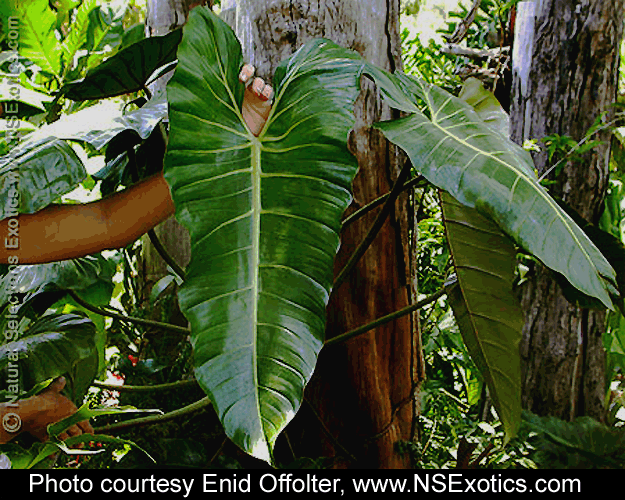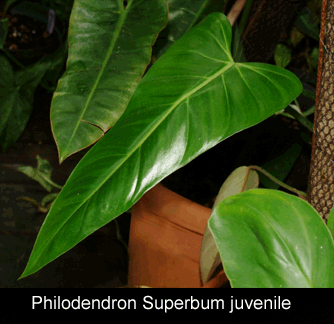![]()
Aroids and other genera in the Collection
Take the Tour Now?
Orchids
The
Exotic Rainforest
Plants in
the Exotic Rainforest Collection
Images on this website are copyright protected. Contact
us before attempting to reuse.
In depth information on how to grow Philodendron species, Click Here
Within our collection we have many species of Philodendron. If you are seeking other photos, click this link
not a scientifically described species

not a scientifically described species

 Philodendron
Superbum (SUPERB-um) is a scientifically undescribed
Philodendron.
Brazilian botanical authority Dr. Eduardo Gonçalves (gon-ZAL-vas)
of the Universidade Catolica
de Brasilia is working on the specimen but to date no technical
information is available other than Philodendron Superbum is an
epiphytic climber that is variable in appearance. An
epiphyte (ep-a-FIT) is a plant that grows upon another plant. The
adaxial (upper) leaf blade surface is glossy and the underside is matte.
Philodendron
Superbum (SUPERB-um) is a scientifically undescribed
Philodendron.
Brazilian botanical authority Dr. Eduardo Gonçalves (gon-ZAL-vas)
of the Universidade Catolica
de Brasilia is working on the specimen but to date no technical
information is available other than Philodendron Superbum is an
epiphytic climber that is variable in appearance. An
epiphyte (ep-a-FIT) is a plant that grows upon another plant. The
adaxial (upper) leaf blade surface is glossy and the underside is matte.
All Philodendron including Philodendron Superbum are aroids. An aroid is a plant that reproduces by producing an inflorescence known to science as a spathe and spadix. Most people believe the spathe is a "flower", it is not. The spathe is simply a specially modified leaf whose purpose is to protect the spadix at the center. On the spadix there can be found very tiny flowers when the plant is at anthesis. When ready to reproduce, the spadix produces male, female and sterile flowers which if pollinated by an appropriate insect, normally a beetle, will produce berries containing seeds
 Philodendron species are
known to be highly variable and not every leaf of every specimen
will always appear the same. As can be seen in the photos on
this page, Philodendron species go through morphogenesis
(ontogeny) as they mature. This link explains in
non-technical language natural variation and
morphogenesis within aroid and other species.
Philodendron species are
known to be highly variable and not every leaf of every specimen
will always appear the same. As can be seen in the photos on
this page, Philodendron species go through morphogenesis
(ontogeny) as they mature. This link explains in
non-technical language natural variation and
morphogenesis within aroid and other species.
Click
here.
My thanks to Enid Offolter
and John Criswick for the use of their photos.
Looking for a specimen? Contact
http:///
Natural Selections Exotics at
Want to learn more
about aroids?
Join the
International Aroid Society:
http://www.exoticrainforest.com/Join%20IAS.html